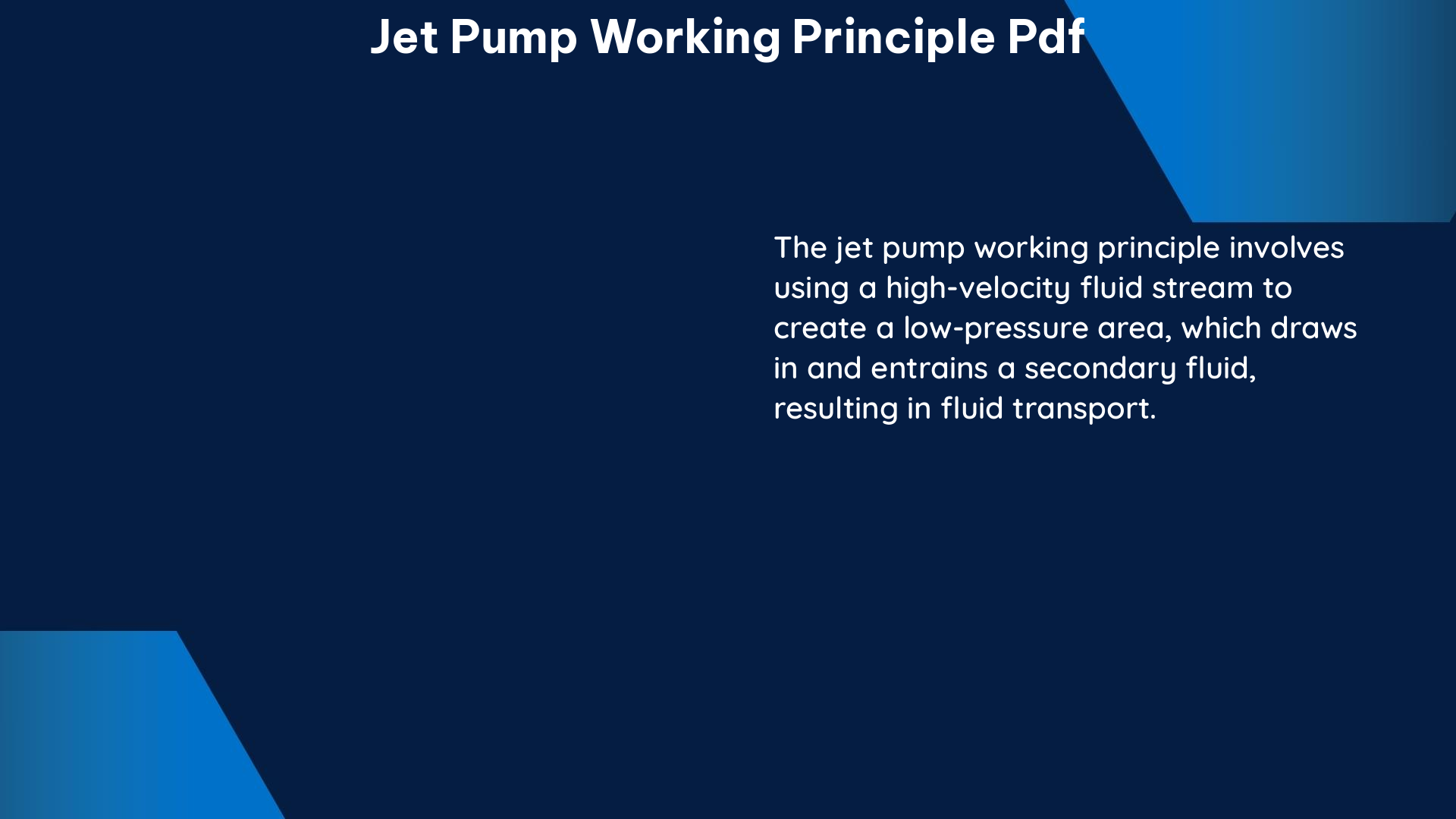The working principle of a jet pump involves the conversion of pressure energy into kinetic energy, which then entrains fluid from the suction section into the mixing tube, where it acquires part of the energy of the motive fluid. The diffuser then reconverts the velocity of the mixture back into pressure.
Theoretical Analysis of Jet Pump Efficiency
The efficiency of a jet pump can be analyzed theoretically and experimentally. The theoretical analysis of jet pump efficiency is based on the following key factors:
- Mass Flow Rates: The primary (motive) flow rate (G1) and the secondary (suction) flow rate (G2) are crucial parameters that influence the efficiency of the jet pump.
- Pressure Ratios: The total pressure ratio (H0/HB) is a function of the mass flow ratio (G2/G1) and the loss coefficients in the jet pump.
- Loss Coefficients: The loss coefficients, such as the nozzle loss coefficient (ζn), the mixing loss coefficient (ζm), and the diffuser loss coefficient (ζd), play a significant role in determining the overall efficiency of the jet pump.
- Diameter Ratio: The ratio of the mixing tube diameter to the nozzle diameter (d2/d1) is another important parameter that affects the jet pump’s performance.
The theoretical jet pump characteristic can be determined by using the derived expression for the total pressure ratio as a function of the mass flow ratio, given specified values of the loss coefficients and the diameter ratio. This curve is valid for geometrically similar jet pumps, regardless of absolute dimensions.
Experimental Evaluation of Jet Pump Efficiency

In addition to the theoretical analysis, the efficiency of a jet pump can also be evaluated experimentally. The experimental method involves the following steps:
- Measurement of Flow Rates: The primary (motive) flow rate (G1) and the secondary (suction) flow rate (G2) are measured using appropriate flow measurement devices, such as orifice plates or venturi meters.
- Pressure Measurements: The pressures at different points in the jet pump, such as the primary nozzle inlet (HA), the mixing tube inlet (HB), and the diffuser outlet (HC), are measured using pressure gauges or transducers.
- Efficiency Calculation: The efficiency of the jet pump can be calculated using the formula:
Efficiency = Q2(H0 – HB) / (G1 HA – G2 HC – G2 HB)
Where:
– Q2 is the secondary (suction) volumetric flow rate
– H0 is the total pressure at the jet pump inlet
– HB is the total pressure at the mixing tube inlet
– HA is the total pressure at the primary nozzle inlet
– HC is the total pressure at the diffuser outlet
The empirical method of design, based on experimental results, is widely used in jet pump engineering calculations. The characteristics and maximum efficiency of a jet pump can be evaluated by determining the absolute dimensions and the values of the loss coefficients.
Factors Affecting Jet Pump Efficiency
The efficiency of a jet pump is influenced by several factors, including:
- Geometry of the Jet Pump: The dimensions and shape of the jet pump components, such as the nozzle, mixing tube, and diffuser, can significantly impact the efficiency.
- Fluid Properties: The physical properties of the fluids involved, such as density, viscosity, and compressibility, can affect the jet pump’s performance.
- Operating Conditions: The inlet pressure, temperature, and flow rates of the primary and secondary fluids can influence the jet pump’s efficiency.
- Cavitation: The formation of vapor bubbles in the low-pressure regions of the jet pump can lead to a decrease in efficiency and potential damage to the pump.
- Wear and Erosion: Over time, the jet pump components may experience wear and erosion, which can degrade the pump’s performance and efficiency.
Practical Applications of Jet Pumps
Jet pumps find widespread applications in various industries, including:
- Water and Wastewater Treatment: Jet pumps are used for fluid transfer, mixing, and aeration in water and wastewater treatment plants.
- Oil and Gas Industry: Jet pumps are employed for well stimulation, enhanced oil recovery, and fluid transportation in the oil and gas industry.
- Chemical Processing: Jet pumps are used for fluid mixing, circulation, and transfer in chemical processing plants.
- HVAC Systems: Jet pumps are utilized in heating, ventilation, and air conditioning (HVAC) systems for fluid circulation and pressure boosting.
- Aerospace and Automotive: Jet pumps are used in various aerospace and automotive applications, such as fuel injection systems and turbochargers.
Conclusion
The working principle of a jet pump involves the conversion of pressure energy into kinetic energy, which then entrains fluid from the suction section into the mixing tube. The efficiency of a jet pump can be analyzed both theoretically and experimentally, and is influenced by various factors, including the geometry of the pump, the fluid properties, and the operating conditions.
By understanding the technical details and the factors affecting jet pump efficiency, engineers and researchers can optimize the design and performance of these versatile devices, leading to improved efficiency and broader applications in various industries.
Reference:
– “Efficiency of Jet Pumps” – ResearchGate
– “VAPOR-JET VACUUM PUMPS (SELECTED CHAPTERS)” – DTIC
– “JET PUMPS” – aei.pitt.edu

The lambdageeks.com Core SME Team is a group of experienced subject matter experts from diverse scientific and technical fields including Physics, Chemistry, Technology,Electronics & Electrical Engineering, Automotive, Mechanical Engineering. Our team collaborates to create high-quality, well-researched articles on a wide range of science and technology topics for the lambdageeks.com website.
All Our Senior SME are having more than 7 Years of experience in the respective fields . They are either Working Industry Professionals or assocaited With different Universities. Refer Our Authors Page to get to know About our Core SMEs.